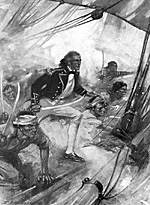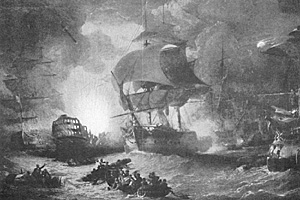Towing The Line
The Evolution Of England's
Naval Officers (1653-1805)
Part 1
by Chris Dorsey, USA
| |
Howe's instructions moved away from Rodney's at the Saints. Instead of following through in succession, Howe postulated bearing down abreast and then coming into line and breaking the enemy's line throughout. The leeward was then taken from the entire fleet, forcing general action. This was partly due to discussions Howe had with Admiral Knowles about the French tactic of continually falling leeward when pressed. 27
Howe's theory again illustrated the chances the English were willing to take to win. Breaking through at all points would indeed force the French to action. The problem was that while approaching in a line abreast to an enemy in line ahead, the force would be open to successive broadsides without the ability to return fire.
Corbett supported this attack if from the windward. According to him, there was no finer movement because it: (1) placed the utmost fire by bringing both broadsides to bear; (2)broke the admirals command and control of his force; (3) refused the French their preferred tactic by taking the leeward from them; (4) forced the French to fight; (6) and allowed concentration along any point of the enemy line. The leeward attack itself was still believed to be best performed with Rodney's tactic. 28
Howe first used his technique on June 1, 1794, at the battle of the same name. The tactic was successful, with the English breaking the line in several places. Six French ships were captured and the Venguer was lost. The entire French line dissolved into scattered groups of vessels. 29 English victories were becoming more decisive and its admirals more daring and willing to adapt their own tactics.
The appointment of Sir John Jervis to the Mediterranean squadron marked an era in the history of naval warfare. His contribution to the evolution was to instill a strong sense of pride and professionalism into his subordinates. He had under his command some of the finest officers in the history of the Royal Navy. 30 The names of Collingwood, Troubridge, Foley, Fremantle, and Thompson would be listed in many victory dispatches over the next decade. In addition to these shining stars was the brightest of all, Horatio Nelson.
Nelson's and Jervis' action at Cape St. Vincent personify the audacity that made them leading figures in English naval doctrine. As the two fleets came into sight, Jervis was receiving word on the enemy strength from a junior officer.
Having far less than twenty-seven, Jervis answered the officer.
The Spanish fleet that faced Jervis was larger in number but did not have the talent of the British fleet. The Spaniards were in two separate columns as the battle was joined. Jervis signaled his intention to pass between the enemy and engage both groups to keep them apart. Nelson observed during the action that the Spanish ships to the rear of his line appeared to be making sail to join up with the other line. Without orders, Nelson wore his ship out of the line and attacked several Spanish ships including the Santissima Trinidad, the largest warship in the world. The Captain sustained heavy damage but succeeded in holding up the Spanish until more support arrived. The victory at St. Vincent allowed Nelson's fame to grow and showed the rewards of allowing competent officers with well-trained crews to take the initiative in battle.
Nelson supplied the first example of what could be called a total victory at Abu Quir Bay. He displayed a keen eye for timing, a flare for the dramatic and exceptional trust in his subordinates or his 'band of brothers' as he called them. Nelson discovered the French fleet at anchor. The problem with attack was there were no reliable master guides to keep the English off the shoals. The keen observation that the French were at swing anchor sparked a brilliant idea in Nelson. If the French ships could swing anchor, then sufficient room was available for his ships to pass on both starboard and larboard of the enemy. The French, unsuspecting of attack, did not have the guns on the landside ready for service. 32
The action was carried out exceptionally. The attack was made at night as the English sailed up to, split and then anchored across from the enemy van. The concentrated fire was devastating on the French. All but two of the French ships were captured or destroyed, with the L'Orient being lost in a brilliant explosion.
Battle of Copenhagen
The battle of Copenhagen also displayed the willingness of a commander to allow subordinate latitude in battle. The assault on the Danish anchored fleet, forts and shore batteries was tough going and several of Nelson's ships were either aground or damaged. Admiral Parker, Nelson's senior, could see his predicament and made the signal for him to disengage, giving him the opportunity to free himself if necessary. Nelson seemed to be enjoying the excitement of the hotly contested battle when his signal lieutenant reported Parker's signal. He at first ignored the junior officer and when the officer persisted he was told to watch the Dutch commander for his signal of surrender. The lieutenant continued and finally Nelson took the eyeglass from him, put it to his bad eye and said, "I really do not see the signal." 33
The Dutch defenders eventually yielded to Nelson. As he was brought aboard Sir Parker's flagship after the conflict, he made a statement that supports the evolution of naval tactics: "I have fought contrary to orders and perhaps shall be hanged. Never mind, let them." 34
This attitude was in stark contrast with Byng at Minorca and illustrates the boisterous independence naval leaders were beginning to display. Parker did not recommend hanging for Nelson, but praised him for his bravery.
The crowning moment for England came at Trafalgar in 1805. Nelson's actions show the acquired traits (although magnified in Nelson) of English sea officers. His rejection of the idea that decisive victory was through centralized 35 control was the final piece to the puzzle of Britain's complete control of the seas. The ability to perceive formations, quickly come upon a course of action and convey orders to subordinates is shown in textbook fashion at Trafalgar. 36
Nelson attacked in two columns with himself and Admiral Collingwood leading. The English vessels withstood the enemy fire as they slowly advanced on the enemy line. Collingwood's line engaged first. His force slammed into the allied rear and Nelson's force separated the van, completing the isolation of the center and rear. Eighteen enemy vessels were captured. 37 This was a great triumph for England, forcing Napoleon to look to the east for future gains. Victory was not without loss, as Admiral Nelson was killed by a French sharpshooter.
Thinking it almost impossible to bring a fleet of forty sail of the line into a Line of Battle with variable winds, thick weather, and other circumstances which must occur, without such a loss of time that the opportunity would probably be lost of bringing the enemy to battle. In such a manner as to make the business decisive; I have therefore make up my mind to keep the fleet in that position of sailing…40
The idea was to come into action quickly and to surprise and confuse the enemy. Nelson, as did most other English officers, had a strong faith in his crews, ships and subordinate officers. What made him great was the ability to readily communicate ideas and wishes to competent officers, making the problem of misunderstood signals less common 41 and leaving ship's captains the freedom to react to situations.
Nelson was the best of a group of officers, who over years of battle, honed their skills to near perfection. Their school was a hard one, with lessons at Beachy Head, Malaga, Minorca and elsewhere. Britain learned from these setbacks and its admirals began to realize that flexibility was the key to victory. Flexibility and faith in the ability of an admiral's subordinates created an aura of ingenuity and excitement that was electric. Captain Blackwood pays homage to this feeling in a letter to his wife after Trafalgar:
Under Lord (Nelson) it seemed like inspiration; the last signal he made was such a one as would immortalize any man. "England expects every officer and man will do their utmost duty." The alacrity with which the individual ships answered it, showed how entirely they entered into his feeling and ideas…and I hope it will convince Europe at large that he has not yet learned enough to cope with the English at sea. 42
He included the telling statement that "Europe…has not yet learned enough to cope with the English at sea." Due to the willingness of its naval officers to break away from the Fighting Instructions and allow for independent operation of its captains, England was far ahead on the evolutionary scale of naval combat and would remain there for many years to come.
1 James L. George, History of Warships. Annapolis, Naval Institute Press, 1998, p. 50.
|
 Other admirals began to refine and improve on Rodney's model. One such admiral was Howe. Howe rose to power under the tutelage and support of Hawke, who appointed him at a young age to command a squadron in 1770. Many senior officers were passed over, but Hawke had seen Howe's analytic abilities and coolness under pressure. 26
Other admirals began to refine and improve on Rodney's model. One such admiral was Howe. Howe rose to power under the tutelage and support of Hawke, who appointed him at a young age to command a squadron in 1770. Many senior officers were passed over, but Hawke had seen Howe's analytic abilities and coolness under pressure. 26  Many have dissected Nelson's action sat Trafalgar. Creswell argues the victory was over a poorly handled fleet. "Apart from hard fighting there could only be the hope that the enemy's commander-in-chief would so misconduct his line" and Nelson's attack would have "lacked logical background against a well-drilled enemy." 38 The question was where was the other well-drilled enemy? Was there another navy that had the same level of seamanship and gunnery skills? England, having the best-trained force, had the advantage of preying upon the enemy's weaknesses. Nelson's willingness to depart from the conventions of the fighting instructions and take the risks necessary for victory reflected the changing attitude of naval warfare. 39
Nelson's memorandum conveyed the essence of offensive naval doctrine:
Many have dissected Nelson's action sat Trafalgar. Creswell argues the victory was over a poorly handled fleet. "Apart from hard fighting there could only be the hope that the enemy's commander-in-chief would so misconduct his line" and Nelson's attack would have "lacked logical background against a well-drilled enemy." 38 The question was where was the other well-drilled enemy? Was there another navy that had the same level of seamanship and gunnery skills? England, having the best-trained force, had the advantage of preying upon the enemy's weaknesses. Nelson's willingness to depart from the conventions of the fighting instructions and take the risks necessary for victory reflected the changing attitude of naval warfare. 39
Nelson's memorandum conveyed the essence of offensive naval doctrine: